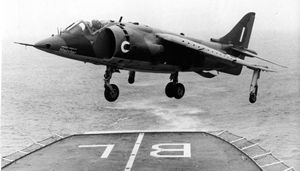Catalogue number 52118
Harrier fighter landing on H.M.S. Blake, 1969
In 1969, the vertical take-off and landing Harrier fighter jet was used to evaluate the possibility of operating these jets from the converted helicopter and command ship H.M.S. Blake. Although such a capacity would have enhanced the operational role of H.M.S. Blake, the ship was outdated, expensive to operate and maintain so the project was abandoned.
Verso: “VTOL Fighter lands on HMS Blake. The Hawker Siddeley Harrier close support jet fighter landing on the flight deck of the cruiser HMS Blake during trials over the weekend 2nd/3rd August. These trials were the result of a directive by the Ministry of Defence for the MOD (Navy), to study the application of the Harrier for operations from ships in the mid-1970s. The aircraft was flown from Dunsfold airfield in Surrey by the Chief test pilot of Hawker Siddeley Aviation Limited (Dunsfold), Mr Hugh Merewether, to HMS Blake which was operating just south of the Isle of Wight. This was the first occasion that the Harrier had landed on a Royal Navy cruiser. HMS Blake (10,000 tons) has a flight deck 117 feet long by 56 feet at the widest point and normally carries a squadron of four Royal Naval Wessex mk3 helicopters. It will carry four Sea King helicopters when these aircraft come into front line service.”
Credit: Crown Copyright, Ministry of Defence (Navy), text Associated Press
19cm x 14.8cm Gelatin silver print
|
 |